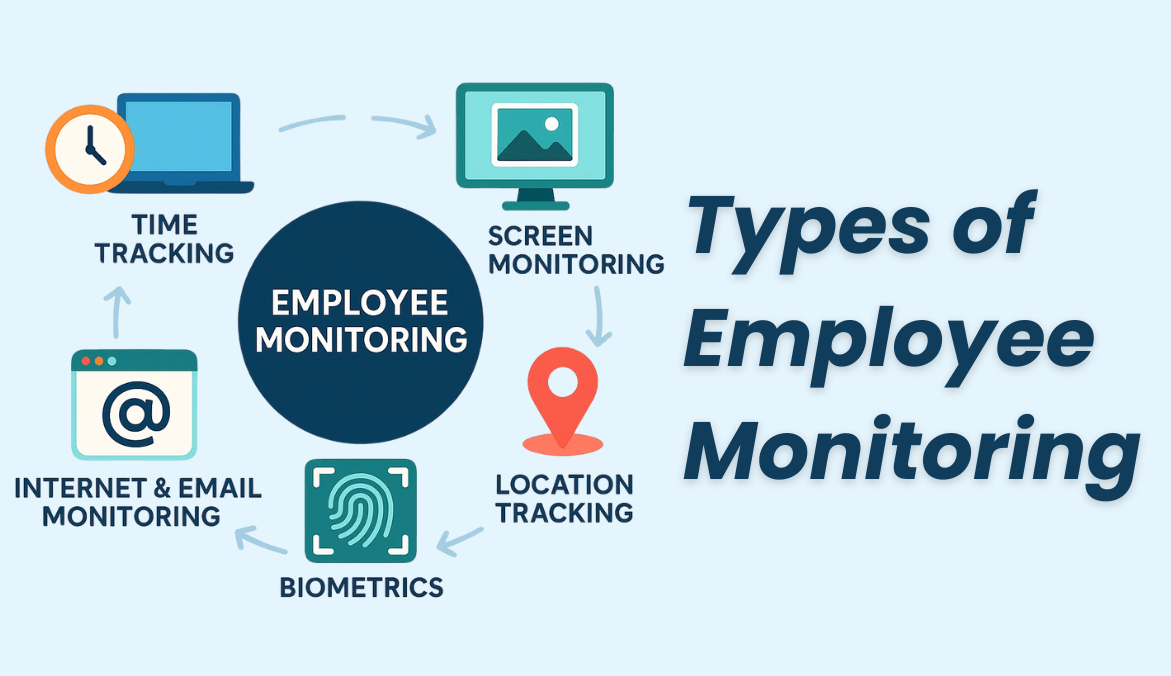Introduction
If you’ve ever felt overwhelmed by the buzz around employee monitoring software, you’re not alone. Business owners and managers often ask me: “There are so many monitoring methods—keystrokes, GPS, time tracking, video… which one actually makes sense for my team?”
I’ve spent over years helping organizations—from startups to global firms—choose and implement monitoring tools. What I’ve learned is simple: there isn’t a one-size-fits-all method. The best choice depends on your goals, your team setup, and how much you care about balancing productivity with trust.
This guide will walk you through the main types of employee monitoring, when to use them, and how to choose the right one without overstepping.
Monitoring Methods at a Glance
- Time & Activity Tracking – tracks app/web usage, idle vs active time.
- Screen Monitoring – captures screenshots or sessions.
- Internet & Email Monitoring – logs browsing/email activity.
- Keystroke Logging – records keystrokes (highly invasive, use with caution).
- GPS & Geofencing – tracks location of field/remote workers.
- Video & Audio Surveillance – cameras, microphones for onsite safety.
- Access & Biometric Control – attendance, secure areas.
👉 And this isn’t rare. Surveys show that 43% of companies already monitor workers’ online activity, and by 2025, 70% of large employers report active monitoring of their staff.
The 3-Step Decision Framework
Whenever leaders ask me “Which monitoring method should I pick?”, I suggest stepping back and running through this simple framework. It helps you avoid shiny-tool syndrome and focus on what really matters.
Step 1: Define Your Goals Clearly
Don’t start with the tool—start with the “why.”
- Do you want productivity insights to understand how time is spent?
- Is your priority billing accuracy because you charge clients by the hour?
- Do you need data security or compliance evidence for audits?
Actionable tip: Write down your top 2–3 objectives. If you can’t explain why you’re monitoring, chances are your team won’t buy into it either.
Step 2: Know Your Constraints
This is where reality checks come in.
- Team setup: Are they in-office, remote, or field-based? GPS might be useful for sales reps but pointless for developers.
- Legal environment: Labor laws vary. For example, keystroke logging is legal in some US states with consent, but tightly restricted under EU’s GDPR.
- Culture & trust: Some workplaces are very output-driven; others are sensitive about privacy. A method that works in one culture may backfire in another.
Actionable tip: I often advise clients to test methods with a pilot group first—it reveals resistance and saves you from a full-scale rollout flop.
Step 3: Match the Fit
Now comes the alignment. Based on your goals and constraints, match the method that solves your pain point without crossing trust boundaries.
- If your top need is billing accuracy, then time tracking is the right fit.
- If your risk is data leaks, internet/email monitoring is more relevant.
- If you’re managing field staff, GPS is the natural choice.
Pro insight: In my experience, companies that succeed don’t use every monitoring tool available. They pick 1–2 methods that give the insights they need, explain the “why” clearly to employees, and keep the rest simple.
The Main Types of Employee Monitoring
Over the years, I’ve seen organizations experiment with almost every monitoring method you can imagine. Some approaches work brilliantly in the right context, while others create resistance or even legal trouble if misused. Let’s break down each type with when to use it, potential pitfalls, and how to get it right.
1. Time & Activity Tracking
This is the backbone of most monitoring systems. It tracks which apps, websites, and documents employees spend time on, and how much of that time is active versus idle.
- Best for: Measuring productivity trends, building accurate timesheets, and understanding team capacity.
- When it works well: In professional services, IT, consulting, or any business where billable hours matter.
- Pitfalls: Over-analyzing small fluctuations can frustrate staff.
Expert tip: Keep it broad—focus on categories like “business apps vs. social media” rather than obsessing over every click. That balance keeps employees comfortable while still giving managers clarity.
2. Screen Monitoring (Screenshots / Session Recording)
This method captures employee screens at intervals or records full sessions. It’s often used where audit trails or client billing transparency are critical.
- Best for: BPOs, financial firms, legal services, or industries with strict compliance needs.
- When it works well: Demonstrating to clients that work was delivered honestly and thoroughly.
- Pitfalls: If used too frequently or without notice, employees may feel spied on.
Expert tip: Use blurred screenshots or capture at random intervals. In one project I advised, this small tweak boosted acceptance rates dramatically because staff didn’t feel micromanaged.
3. Internet & Email Monitoring
Tracks web browsing patterns and email activity to flag misuse, risky sites, or potential data leaks.
- Best for: Large organizations, regulated sectors, and roles dealing with sensitive client data.
- When it works well: Preventing accidental data breaches or inappropriate email use.
- Pitfalls: Reading individual emails creates serious privacy concerns.
Expert tip: Monitor domains and categories, not personal messages. For example, flagging gambling or unsafe sites makes sense—but digging into someone’s personal email thread will quickly erode trust.
📊 According to the APA, over 56% of employees report feeling tense or stressed when they know they’re being electronically monitored. That’s why transparency is non-negotiable here.
4. Keystroke Logging
This is the most extreme form of monitoring—recording every key pressed.
- Best for: Rarely. Only for forensic investigations or specific legal/security cases.
- When it works well: Very limited use in highly sensitive environments (e.g., fraud investigations).
- Pitfalls: Extremely invasive, often illegal or restricted under privacy laws like GDPR.
Expert tip: In 12+ years, I’ve rarely recommended keystroke logging. It damages trust and usually has safer alternatives.
5. GPS & Geofencing
Tracks employees’ physical location during work hours. Essential for mobile and field-based teams.
- Best for: Sales reps, delivery staff, logistics, and construction.
- When it works well: Tracking routes, verifying on-site attendance, or ensuring safety compliance.
- Pitfalls: Tracking outside of work hours creates backlash.
Expert tip: Limit tracking to scheduled shifts. I’ve seen trust collapse instantly when companies track someone’s movements after hours.
6. Video & Audio Surveillance
Traditional monitoring using cameras and sometimes microphones in the workplace.
- Best for: Retail, manufacturing, warehouses, or any environment where theft prevention and safety are priorities.
- When it works well: Protecting inventory, enforcing safety regulations, or investigating incidents.
- Pitfalls: Lack of signage or transparency can lead to legal issues.
Expert tip: Always communicate clearly. In one retail rollout I supported, just putting up “monitored for your safety” signage improved both compliance and employee acceptance.
7. Access Control & Biometrics
Uses swipe cards, fingerprints, or facial recognition to control access and log attendance.
- Best for: Tracking attendance, securing restricted areas, labs, or high-security environments.
- When it works well: Ensuring only authorized staff enter sensitive zones.
- Pitfalls: Employees may push back on biometrics if they feel it invades privacy.
Expert tip: Offer alternatives like badges or PINs for those uncomfortable with biometrics—it shows flexibility and builds goodwill.
Legal & Compliance Basics
- US: Laws vary by state. Most require notice or consent (ECPA). Some sectors (finance, healthcare) have stricter rules.
- EU: GDPR requires a lawful basis, transparency, data minimization, and data protection impact assessments (DPIAs).
Actionable advice: If you take one step, draft a simple Monitoring Policy and share it openly with staff. Transparency reduces fear.
Implementation Checklist (Privacy-First)
- Involve stakeholders (HR + IT + legal).
- Pilot test with one team before full rollout.
- Limit monitoring scope (only during work hours, only work devices).
- Train managers: monitoring should empower, not micromanage.
- Review policies yearly.
Expert tip: In one rollout I led, adoption doubled when we involved employees early and showed them their own dashboards. Suddenly, it wasn’t “management spying”—it was their productivity tool.
Measuring Success
- Productivity: focus vs idle ratios.
- Compliance: fewer incidents, faster audits.
- Engagement: employee survey sentiment (measure trust alongside output).
Real-World Fit by Role
- IT & Engineering: Activity tracking + light DLP.
- Sales & Field Ops: GPS + time tracking.
- Finance/Healthcare/Call Centers: Screen monitoring + access control.
Tools Landscape
Plenty of tools offer combinations of these methods—Teramind, ActivTrak, Hubstaff, Time Doctor. Each takes a different approach.
And yes, don’t miss Mera Monitor: it combines time tracking, activity monitoring, and reporting with role-based permissions—so you can stay productive without crossing trust boundaries.
Conclusion
Monitoring isn’t about “spying.” It’s about aligning productivity, compliance, and trust. Choose the method that matches your goals—not just the most powerful one.
And if you want to see what privacy-first monitoring looks like, try Mera Monitor. It’s built to give clarity to managers and confidence to employees.
FAQs
The most common methods include:
- Time & Activity Tracking (apps, websites, idle vs active time)
- Screen Monitoring (screenshots, session recording)
- Internet & Email Logs (web usage, email patterns)
- Keystroke Logging (records every key typed – highly invasive, rarely used)
- GPS & Geofencing (location-based tracking for field teams)
- Video & Audio Surveillance (on-premises security and safety)
- Access Control & Biometrics (attendance systems, restricted areas)
Each type serves different goals, some are productivity-focused, others are about compliance or security.
For remote or hybrid employees, the most effective and accepted methods are:
- Time & Activity Tracking → helps measure productivity trends and time spent on apps or tasks.
- Screen Monitoring → useful for compliance-heavy roles (like finance or client deliverables), but should be used sparingly with privacy-friendly settings.
In practice, a mix of time tracking + lightweight screen monitoring works well, especially if combined with transparency (showing employees their own dashboards).
Keystroke logging is one of the most invasive methods.
- In some regions, it’s legal with employee consent (like parts of the US).
- In others (EU under GDPR), it’s often prohibited or tightly restricted.
- Even where it’s legal, it can damage employee trust significantly.
👉 Safer alternatives include time tracking with activity summaries or screen monitoring at intervals. Always check your local labor and privacy laws before considering keystroke logging.
The key is to focus on outcomes, not every click.
- Use aggregate metrics (e.g., productive vs unproductive app time, project completion rates).
- Share results with employees—let them see their own data too.
- Encourage self-management by positioning monitoring as a tool for coaching and improvement, not surveillance.
In my experience, teams are more receptive when monitoring is framed as “insights for growth” rather than “proof for punishment.”
Yes, and many companies do—but balance is everything.
- For example, a field sales team might need GPS + time tracking.
- A finance or call center team might need screen monitoring + access control.
- Too many methods at once can feel invasive and hurt morale.
The best approach is to combine only 2–3 methods that directly support your goals (productivity, security, compliance). Always explain the “why” behind your choice to employees.
 Gift Card ₹999
Gift Card ₹999

